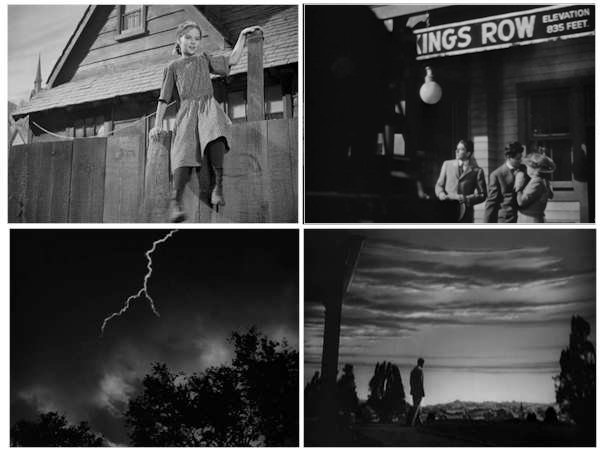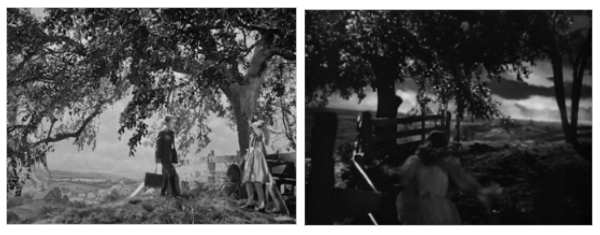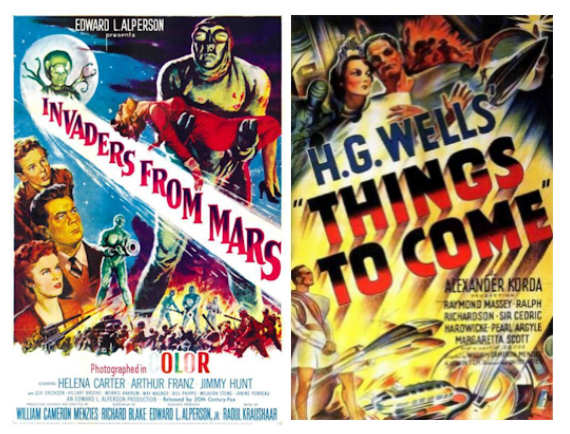This is a paper I wrote for the SCMS 2011 Confererence, which took place last March in New Orleans. A family emergency prevented me from attending, so my colleague and good friend Chris Dumas — who organized our panel on Kings Row (Sam Wood, 1942) — kindly gave the presentation in my absence. The essay’s full title, too long for this blog, is ” ‘Each of Us Live in Multiple Worlds’: William Cameron Menzies and In/Visible Production Design Between Classical and Digital Hollywood.”
1: A Not-So-Clumsy Sublime
As a student of special effects, the first time I saw Kings Row my attention was drawn inevitably to those points in the movie where artifice tips its hand: animated lightning bolts superimposed against a stormy sky; a miniature train passing between the camera and what appears to be rear-projected footage; and most of all the backdrops that pervade the film – painted cycloramas of rolling, pastoral hills, the roof lines of houses and mills, vast skies piled with billowing clouds.
Such moments, which are vital not just to establishing the town of Kings Row as narrative space but to mapping the idyllic and nightmarish polarities of Kings Row as cinematic experience, form an inextricable part of the film’s texture. In that they also mark interventions by studio trickery, they also document the operations of classical Hollywood during a key period in the development of its illusionistic powers, when emerging articulations among shooting script, art direction, and visualization technologies – choreographed by a new managerial category, the production designer – set the industry on a path that would lead, some seventy years later, to the immersive digital worlds of contemporary blockbuster franchises.
Writing about the use of rear-projection in classical Hollywood, Laura Mulvey has coined the term clumsy sublime to refer to that weird subset of screen imagery in which a cost-saving measure – in her example, filming actors against previously-captured footage – results in a burst of visual incongruity whose “artificiality and glaring implausibility” in relation to the shots that bracket it invites a different kind of scrutiny from the spectator.[1] There is an echo here of Tom Gunning’s famous formulation of the early-cinema “attraction,” which presents itself to appreciative viewers as a startling sensorial display,[2] but Mulvey’s point is that rear projection was rarely intended to be noticed in its time; it only “seems in hindsight like an aesthetic emblem of the bygone studio era.”[3] Like the attraction, the clumsy sublime destabilizes our ontological assumptions about how the image was made (indeed, its impact stems largely from our sudden awareness that the image was manufactured in the first place). But where Gunning argues that contemporary, spectacular special effects carry on the highly self-conscious work of what he calls the “tamed attraction,” the clumsy sublime suggests a more contingent and even contentious relationship to cinema’s techniques of trompe l’oeil, in which illusions originally meant as misdirective sleight-of-hand acquire with age their own aura of movie magic.
Looking at Kings Row as a special-effects film, then, invites us to redraw the borders between visible and invisible special effects – those meant to be noticed as spectacles in themselves and those meant to pass as seamless threads in the narrative fabric – and to consider the degree to which such an apparently obvious distinction, like those that once applied to practical versus optical effects, and which now separate analog from digital modes of production, flows not from some innate property of the artifact but from the cultural and industrial discourses that frame our understanding of film artifice itself.
2: William Cameron Menzies and the Visualization of Kings Row
As David Bordwell observes in his blog post “One Forceful, Impressive Idea,” William Cameron Menzies was a pivotal figure in the evolution of film design.[4] After rising to prominence as an art director during the 1920s, he coordinated key sequences of Gone with the Wind, where he originated the title of production designer. Menzies’s detailed breakdowns of each shot, in addition to demonstrating his particular expressionist tendencies (strong diagonals, stark lighting contrasts, forced-perspective settings, and dramatically high or low camera angles), embodied a newly integrative philosophy of composing for the frame. Just as Menzies was an interstitial figure in whom were subsumed those functions of the director and cinematographer having to do with conceiving shots and scenery in dialogue with each other, his sketches and drawings embedded within themselves multiple phases of film manufacture, designating, in addition to set design and actor blocking, “the camera’s viewpoint, the lens used, and any trick effects.”[5] In this way, the first mature storyboards blurred temporal and technological lines between practical and optical special effects, pre- and post-production, while Menzies himself complicated auteurist assumptions about cinematic authorship, leaving his distinctive signature on the movies in which he played the greatest role behind the scenes – in Bordwell’s description, “abduct[ing] these films from their named directors.”[6]
This seems to have been especially true of Sam Wood, whose three-year, five-film partnership with Menzies included Our Town (1940) and The Pride of the Yankees (1942). Kings Row, while neither as lyrical as the former nor as blunt as the latter, represents a more restrained and oblique application of Menzies’s skills, eschewing obvious flourishes in favor of a more controlled approach in which the most elaborate manipulations of time and space are snugly folded into the narrative fabric. Consider, for example, the opening moments: a horse-drawn wagon, silhouetted against a characteristically sky-dominated frame, crosses the prairie as the opening credits play. As the wagon crosses between the camera and a sign reading Kings Row, there is a cut, taking us from footage shot on location to a backlot setting. A rightward tracking shot continues the motion, bringing into view an elementary school from which children emerge, including young versions of protagonists Parris Mitchell, Drake McHugh, and Cassie Tower. The soundtrack’s singing voices hover somewhere between the diegetic and nondiegetic, paralleled by Erich Wolfgang Korngold’s score, evoking the happy play of children while foreshadowing the psychoanalytic themes of the rest of the film.
The efficient encapsulation of plot information, so typical of classical Hollywood narration, is here conveyed through what is essentially a virtual shot stitched together from “real” and “artificial” elements, prefiguring the digitally-assisted establishing shots now commonplace in cinema.
An even more complex assemblage occurs later in the film, as Parris departs to begin his studies abroad. From a long shot of Drake, Parris, and Randy Monaghan on the platform, we cut to a different angle on the same scene, the image degraded and grainy in a way that suggests second-generation footage. Echoing the earlier left-to-right motion of the wagon, a train sweeps into the frame, its miniature status given away by the lack of focus on the foreground element. As the train slides past, a carefully-timed wipe shifts us back to a medium closeup of Randy and Drake. A shot-reverse-shot series shows Parris waving goodbye as the train carries him around the bend, the painted backdrop of the mill in the distance.
Elegant for their era, both of these brief passages presumably passed unnoticed by their initial audience, but with the passage of time, their sleight-of-hand has become more evident, constituting new nodes of fascination in a film text that is also – like all movies, but especially those that depend on special effects – indexical evidence of its own manufacture.
Perhaps the most eloquent of Menzies’s contributions to Kings Row are the cycloramas that pepper the film, lending it a painterly, faintly uncanny air. This feeling is present in the town’s train yard as well as its flowery fields, framing the actors in front of them in a theatrical amber similar to that which Mulvey ascribes to rear projection:
Performances … tend to become self-conscious, vulnerable, transparent. The actors can seem almost immobilized, as if they are in a tableau vivant, paradoxically at the very moment in the film when there is a fictional high point of speed, mobility, or dramatic incident.[7]
But in Kings Row the effect of the painted backdrops is different: less of an interruption, more in synch with the story’s themes. The town of Kings Row is, after all, a kind of beautiful trap, nurturing its children only to imprison them like drawings in a storybook, and beneath the pastoral languor of its more innocent vistas run undercurrents of the poisonous, narcotic, or – to adopt the film’s medicinal metaphor for its sadistic counterforces – anesthetic.
Oppositions between innocence and corruption, the sublime and the malign, that shape the film’s darker turns (Cassie’s madness, Dr. Tower’s murder-suicide, the double castration of Drake’s bankruptcy and amputation) are most evident in the shifting portrayal of its most important site, the fence line running along the Mitchell property – a space of transition whose markings of studio artifice reinforce, rather than dilute, its metamorphic extremes.
3. Building Better Screen Worlds, Then and Now
The productions for which William Cameron Menzies is perhaps most remembered are his two forays into science fiction: Things to Come (1936) and Invaders from Mars (1953), whose (admittedly very different) deployments of SF iconography enabled him to indulge his penchant for striking visual invention. His industrial legacy bears out this genetic pairing of strong, centrally-organized production design and the genres of science fiction and fantasy, whose storyworlds tend to be built from the ground up, and whose product differentiation in terms of franchise potential require the creation of distinct brand identities, recognizable by consumers and defensible by the intellectual-property law that polices a minimum necessary distance between, say, the stylistic universes of Star Wars and Star Trek, or between Harry Potter and The Chronicles of Narnia. The tools available to Menzies in crafting his worlds can be traced to the Special Effects Department at Warner Brothers, where artist-technicians such as Hans Koenekamp, Byron Haskin, and the effects supervisor for Kings Row, Robert Burks, worked on countless films from the 1920s to the 1960s.[8] Their glass shots and matte paintings – as well as their practical effects work such as the creation of wind, lightning, and other environmental effects – have their contemporary counterpart in the digital set extensions and CGI elements whose near-ubiquity says less about the inventiveness of our current screen wizardry than about its vastly increased speed and efficiency.
The classical and analog roots of digital modes of production remain relatively unexcavated in modern special-effects scholarship, whose coherence as a subdiscipline of film and media studies began with the advent of computers as all-purpose filmmaking tools and fixture of the popular imagination in the late 1990s. But as CGI performs one type of spectacular labor though its monsters, explosions, and spaceships while distracting us from its more quotidian augmentations of mise-en-scène, critical film theory stands to benefit from considering the present era’s counterintuitive linkages to the golden age of Hollywood, which foregrounded smooth verisimilitude through an equally intricate web of technological trickery.
The clumsy sublime, product of a time-based calculus of spectatorship and a shifting state of the art, is an important tool in this critique, in part because it enables new readings of familiar film texts. Seen through the lenses of technology and style that special-effects history provides, a film like Kings Row seems less like a dated artifact than a predictor of the present. For just as its narrative, set at the end of the 19th century and dawn of the 20th, stages on a manifest level the birth of psychoanalysis, its production stages in latent terms the emergence of a filmic apparatus for the production of expressive screen worlds.
[1] Laura Mulvey, “A Clumsy Sublime,” Film Quarterly 60.3 (2007).
[2] Tom Gunning, “The Cinema of Attractions: Early Film, Its Spectator, and the Avant-Garde,” in Early Cinema: Space, Frame, Narrative (Ed. Thomas Elsaesser. London: BFI, 1990), 56-62.
[3] Mulvey, “A Clumsy Sublime.” Emphasis added.
[4] David Bordwell, “One Forceful, Impressive Idea,”
http://www.davidbordwell.net/essays/menzies.php (accessed March 1, 2011).
[5] Ibid.
[6] Ibid.
[7] Mulvey, “A Clumsy Sublime.”
[8] Peter Cook, “Warner Bros. Presents … A Salute to the Versatility and Ingenuity of Stage 5: Warner’s Golden Era Effects Department,”
http://nzpetesmatteshot.blogspot.com/2010/08/warner-bros-presents-sulute-to.html (accessed February 25, 2011).







